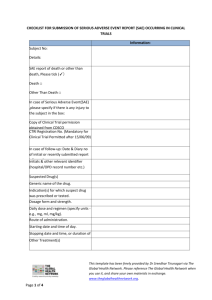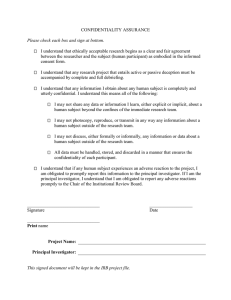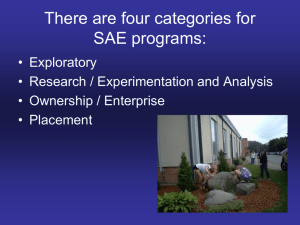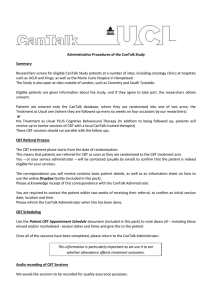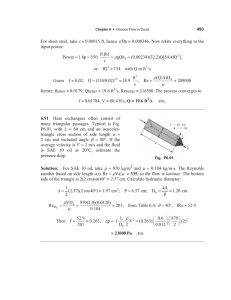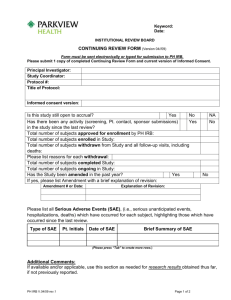A Serious Adverse Event (SAE) is an untoward occurrence experienced... results in death; CanTalk - Serious Adverse Events Protocol
advertisement
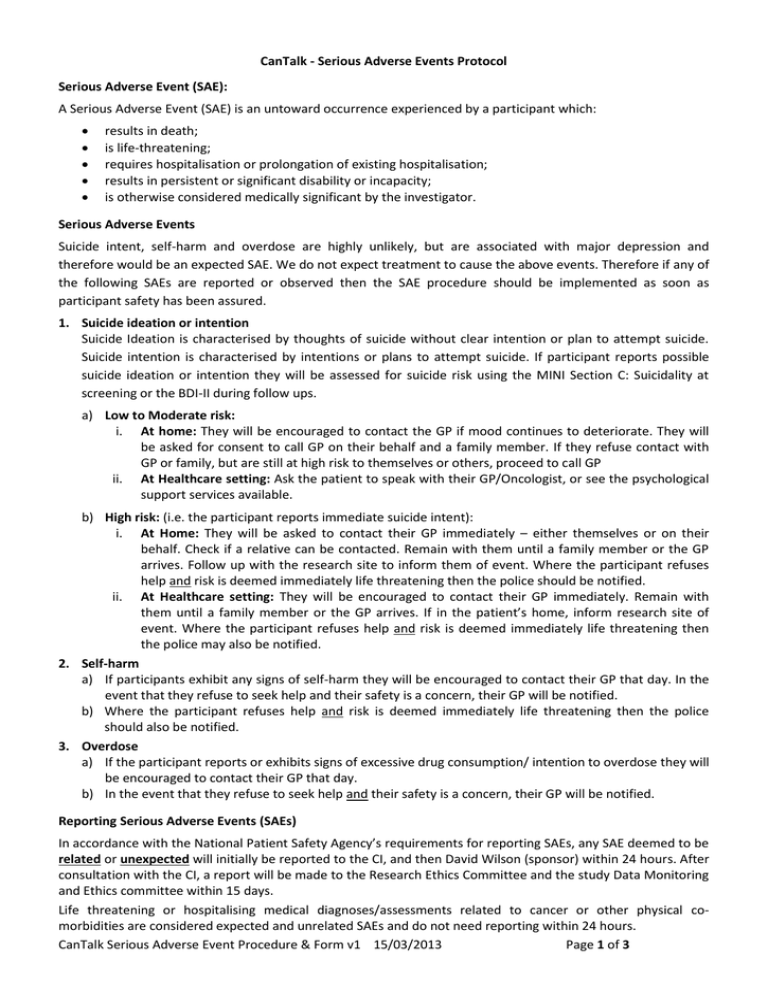
CanTalk - Serious Adverse Events Protocol Serious Adverse Event (SAE): A Serious Adverse Event (SAE) is an untoward occurrence experienced by a participant which: results in death; is life-threatening; requires hospitalisation or prolongation of existing hospitalisation; results in persistent or significant disability or incapacity; is otherwise considered medically significant by the investigator. Serious Adverse Events Suicide intent, self-harm and overdose are highly unlikely, but are associated with major depression and therefore would be an expected SAE. We do not expect treatment to cause the above events. Therefore if any of the following SAEs are reported or observed then the SAE procedure should be implemented as soon as participant safety has been assured. 1. Suicide ideation or intention Suicide Ideation is characterised by thoughts of suicide without clear intention or plan to attempt suicide. Suicide intention is characterised by intentions or plans to attempt suicide. If participant reports possible suicide ideation or intention they will be assessed for suicide risk using the MINI Section C: Suicidality at screening or the BDI-II during follow ups. a) Low to Moderate risk: i. At home: They will be encouraged to contact the GP if mood continues to deteriorate. They will be asked for consent to call GP on their behalf and a family member. If they refuse contact with GP or family, but are still at high risk to themselves or others, proceed to call GP ii. At Healthcare setting: Ask the patient to speak with their GP/Oncologist, or see the psychological support services available. b) High risk: (i.e. the participant reports immediate suicide intent): i. At Home: They will be asked to contact their GP immediately – either themselves or on their behalf. Check if a relative can be contacted. Remain with them until a family member or the GP arrives. Follow up with the research site to inform them of event. Where the participant refuses help and risk is deemed immediately life threatening then the police should be notified. ii. At Healthcare setting: They will be encouraged to contact their GP immediately. Remain with them until a family member or the GP arrives. If in the patient’s home, inform research site of event. Where the participant refuses help and risk is deemed immediately life threatening then the police may also be notified. 2. Self-harm a) If participants exhibit any signs of self-harm they will be encouraged to contact their GP that day. In the event that they refuse to seek help and their safety is a concern, their GP will be notified. b) Where the participant refuses help and risk is deemed immediately life threatening then the police should also be notified. 3. Overdose a) If the participant reports or exhibits signs of excessive drug consumption/ intention to overdose they will be encouraged to contact their GP that day. b) In the event that they refuse to seek help and their safety is a concern, their GP will be notified. Reporting Serious Adverse Events (SAEs) In accordance with the National Patient Safety Agency’s requirements for reporting SAEs, any SAE deemed to be related or unexpected will initially be reported to the CI, and then David Wilson (sponsor) within 24 hours. After consultation with the CI, a report will be made to the Research Ethics Committee and the study Data Monitoring and Ethics committee within 15 days. Life threatening or hospitalising medical diagnoses/assessments related to cancer or other physical comorbidities are considered expected and unrelated SAEs and do not need reporting within 24 hours. CanTalk Serious Adverse Event Procedure & Form v1 15/03/2013 Page 1 of 3 CanTalk - Reporting serious adverse events (SAEs) Flow Chart Notification of adverse event received Is the incident assessed as serious? In the CanTalk study a Serious Adverse Event (SAE) is an untoward occurrence, experienced by the participant, which: Resulted in death; Was life-threatening; Required hospitalisation or prolongation of existing hospitalisation; Resulted in persistent or significant disability or incapacity; Is otherwise considered medically significant by the principal investigator. No No further action required. Within 24 Hours Yes 1. A Researcher or Principal Investigator (PI) should complete Section A of the CanTalk Serious Adverse Event (SAE) Form electronically. If completed by a Researcher, the SAE Form should then be forwarded to their local PI. 2. The PI should complete Section B of the SAE Form electronically, as far as possible. 3. 4. The PI should send the SAE Form electronically to: m.serfaty@ucl.ac.uk and t.aspden@ucl.ac.uk 5. The PI should print 2 copies and sign and date both forms. One should be retained in the Investigator’s Site File and the other should be sent to: Mr. Trefor Aspden CanTalk Trial Manager UCL Division of Psychiatry 1st Floor Charles Bell House 67-73 Riding House Street London W1W 7EJ 6. At UCL, the Chief Investigator should complete Section C of the SAE Form. 7. Where the SAE is deemed to be related to the CanTalk trial, the CI will notify (within 15 days) the following: i. Main REC; ii. Trial DMEC. 8. The SAE Form should be filed in the Trial Master File (TMF). CanTalk Serious Adverse Event Procedure & Form v1 15/03/2013 Page 2 of 3 CanTalk SERIOUS ADVERSE EVENT (SAE) REPORTING FORM 01 02 04 05 Patient’s Initials. Hospital Name. Date of Birth. 03 Participant’s Trial No. Responsible Clinician. SECTION A: 06 07 Please indicate below the category which best describes the SAE. Date of SAE: 1 = Death 2 = Life-threatening (including attempted suicide, overdose, self-harm) 3 = Requires hospitalisation or prolongation of existing hospitalisation 4 = Results in persistent or significant disability or incapacity 5 = Other (considered medically relevant), specify …………………………………………………. 08 Where did the SAE happen 09 How did the centre become aware of the incident? 10 Descibe serious adverse event : SECTION B: To be completed by the Principal Investigator 11 Did this SAE arise as a result of the participant’s involvement in the CanTalk trial? Yes □ No □ 12 Any other comments 13 Name of PI (print) 14 Signature of PI 15 Date Please print two copies. Please send by post to the address below and retain a copy for the Site File. Mr. Trefor Aspden CanTalk Trial Manager UCL Division of Psychiatry 1st Floor Charles Bell House 67-73 Riding House Street London, W1W 7EJ SECTION C: To be completed by Chief Investigator 16 Action Take ……………………………………………………………………………………………………………………………………. 17 Name of CI (print) …………………………………………………………………………….. 18 Signature of CI ………………………………………………………………… CanTalk Serious Adverse Event Procedure & Form v1 15/03/2013 19 Date _ _ / _ _ / _ _ _ _ Page 3 of 3
